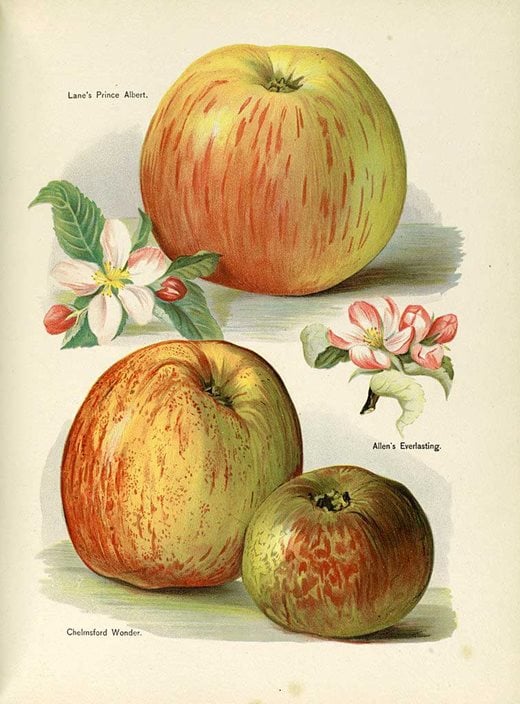
- Botanical name: Malus domestica
- Origins: DNA analysis has traced back the origins of the domestic apple to a small region on China’s border with Kazakhstan and the wild species M. sieversii
- First cultivated: There is evidence that wild apples grew in Neolithic Britain, but it was the Romans who brought sweeter-tasting varieties to the UK
- Types: More than 7,500 apple varieties are grown world-wide
- Skill level: Possibly the easiest fruit to grow in the garden
- Preferred location and conditions: Ideally, full sun on fertile, moisture-retentive, loamy soil with plenty of added organic matter. Avoid shallow soils over chalk.
- Good for containers: Yes – if produced on dwarfing rootstocks
- Harvest time: Late summer – early autumn
- Possible problems: A range of problems affect apples, but these can usually be avoided with careful management and cultivar selection. Read more
- Health benefits: Often ranked by medical experts as the number one health food, apples are high in vitamin C, B-6, riboflavin, thiamin and disease-fighting antioxidants and phytonutrients. They contain no fat, sodium or cholesterol and are a good source of fibre. They also offer good levels of minerals such as calcium, potassium and phosphorus.
 Potted history
Potted history
The first British apple orchards were implemented by the Romans. Many of these were abandoned following Roman departure, due to raids by the Jutes, Saxon and Danes. It was not until after the Norman Conquest that orchards were redeveloped with improved varieties from France.
Many of the Norman orchards were developed in the grounds of monasteries, with monks undertaking cross pollination work to develop new varieties. One of these, 'Costard', was widely grown by the 13th century, the fruits of which were sold by ‘costardmongers’, from where we take the word ‘costermonger’ for a general fruit and vegetable seller. The variety remains available to gardeners today.
UK apple growing declined again during the War of the Roses and Black Death, until 150 years later in Tudor times, when Henry VIII instructed his fruiterer Richard Harris to source new varieties for introduction to his orchard in Teynham, Kent. Though the first 'Pippin' was introduced from France at this time, 'Queene' was the most common Tudor apple.
By the mid 17th century, some 60 cultivars were recorded in UK production, divided by use: eating, cooking, cider and pomatum - an ointment used to treat skin ailments. Perhaps the most renowned of the time is cooking apple 'Flower of Kent', one of which fell next to Sir Issac Newton, inspiring his understanding of gravitational force.
Apple breeding and cultivation hit its peak in the late 19th and early 20th centuries, with the introduction of many varieties that remain in popular today. Extensive hybridisation work was carried out in estate gardens and by commercial nurserymen in a bid to produce outstanding flavour. Richard Cox introduced 'Cox’s Orange Pippin' in 1850, and 'Bramley’s Seedling', still considered the very best cooking apple and was first exhibited in 1876.
The development of new rootstocks following the Second World War brought the height and habit of apple trees under control, vastly improving orchard production, but also making apples trees better suited to smaller gardens. Great success can now even be had on the smallest of patios or balconies with varieties on dwarf rootstocks that are ideal for growing in pots. The various training methods – fan, cordon, espalier, step over etc. mean that apples can be grown in almost any garden situation, no matter the available space.
Why grow apples?
Apples are easy to grow and are an excellent investment for the garden, going on to produce bumper crops for many years. With so much choice on offer it can be hard to choose the right cultivar for your needs and situation. See our advice on choosing apple cultivars.
For the best fruit production some annual pruning is required, and this will differ depending on your preferred training method and whether your tree produces fruit on the shoot tips or on fruiting spurs along the branches. Fruit pruning can be a little unnerving for new growers but don’t let the process put you off. Our easy pruning guide should set you on the simple road to success.
Planting and growing: Autumn to spring is the best time to plant apples, though container grown trees can be planted at any time of year. Bare-root trees are available in the dormant season and these offer an economical and easy start to apple growing.
For the best pollination and fruit set, apple trees require pollen from a different cultivar, though a few self-fertile varieties are available. Where space is available two or more trees from the same or adjacent pollination group. However, there are often so many apple trees growing in neighbouring gardens or public land that there is a high chance your chosen apple tree could be pollinated anyway. For compatible varieties download our Apple pollination groups fact sheet.
Trees should be staked and tied against wind rock and for best fruit production and feed each year in late winter/early spring with a high potassium feed. Newly planted trees should also be mulched in spring and autumn for the first three or four years to conserve moisture and reduce competition from weeds and grass.

